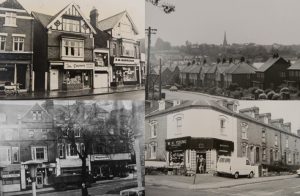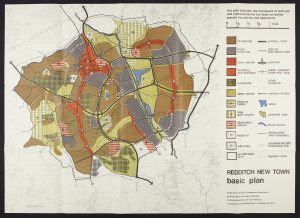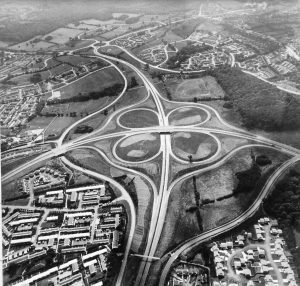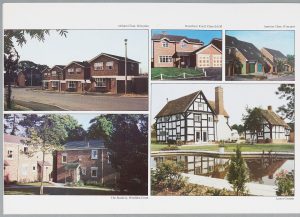Redditch New Town Archives: Planning & Design
- 20th February 2024
Planning for a New Town
Unlike most other New Towns, Redditch had a rich history, dating from the year 1140 when Cistercian monks founded Bordesley Abbey in the Arrow Valley, through to its more recent industries in needle-making, fish-hooks and motorcycle production. Redditch Development Corporation therefore had a slightly different task to most. They had to modernise and expand the town as opposed to starting more or less from nothing.
The Redditch New Town archives contain several photos. Many of these feature ‘old Redditch’ such as shops, homes, the market, businesses and workshops, in addition to photos capturing building work in progress and special events. Anecdotally, it was the Reprographics Manager at Redditch Development Corporation who was responsible for most of the copies of drawings and photos, which he developed in his dark room. We have been told he took photos of everything and everyone, much to a researcher’s delight! The photos form part of the collection that is being retro converted as part of our New Jerusalems project. As a result they will be available to search online in our catalogue.

Photos showing parts of Redditch pre-development. 1960s-70s. 449:4 BA11883/54 Top left: 49 – 55 Alcester Street; top right: Hewell Road; bottom left: 2 – 10 Unicorn Hill; bottom right: Beoley Road and Prospect Road.
The Master Plan
As part of the New Jerusalems project, the colourful basic plan of c.1966 has been catalogued, together with accompanying master plan at finding no. 009:12 BA14226/26(2) which includes detailed information about the concept and principles. The plan illustrates the intended re-development for Redditch New Town. The bead-like districts were designed to be relatively self-contained, each with their own local amenities. The beads are on a transport route ‘string’. The unique design sought to integrate the old and new town along with accommodating the incoming population. The target would eventually become 90,000 by 2001. In 1966 the Master Plan was approved by the RDC Board, being based on the Interim report by Master Planner Hugh Wilson (later, Sir).

RDC Basic Plan. 1966. ref 009.12 BA1422626/2
This street index is one of several library publications in the collection. It shows the outcome of redevelopment in some detail and so is useful to compare to the Basic Plan.
![RNT Map with Street Index (front) [1974] 499:4 BA10300/787](https://www.explorethepast.co.uk/wp-content/uploads/2024/02/04-reduced-300x213.jpg)
RNT Map with Street Index (front) [1974] 499:4 BA10300/787
Managing Flows of Traffic and Water
The Corporation approved a cloverleaf interchange that is grand in proportion, and one of only two surviving in the UK, the other being in Edinburgh. Only three have ever been built in Britain. Cloverleaves are a simple junction used where two motorway-type roads meet. It is possible to continually lap round a clover leaf without ever coming off!

The River Arrow had already been re-routed by Cistercian Monks of Bordesley Abbey but the river still made the area to the east prone to flooding. This was a problem for the planners wanting to build areas of homes and industrial sites! In mid 1960s-70s it was therefore necessary to re-route the river again. To avoid the risk of flooding, the Arrow Valley Lake was created. It provided an area to bond ‘old Redditch’ with new areas such as the Winyates residential estate.

Photo of Arrow Valley Lake BA11883-87iii
Housing Provision
Our own archaeology case study explains, ‘Views were identified as important for the New Town and veteran trees and hedgerows were preserved within housing estates to enhance the natural feeling of the environment. Winyates Green, has a large area of mature woodland at its centre. This also meant that much of the historic field pattern was encapsulated in the new developments and many other archaeological remains were also preserved.’ The provision of houses at this stage was adapted to meet a demand different to that originally expected from the incoming population, resulting in homes being designed for fewer persons per household.

10,000th House in Redditch Publicity Brochure c.1979. 499:4 BA10300/123(3)
Societal changes meant there was more demand for single occupancy homes. An increase in divorced parents lead to more ‘single parent’ households. In addition, more couples were choosing to defer having children, due to higher mortgage and interest rates. The Quantocks, Yardley Close, Winyates won an award in 1979. The Chief Architect and Planning officer of the Corporation was Brian Bunch, bringing experience with him from Stevenage New Town, amongst other locations. (Information taken from The History of Redditch New Town by Gordon Anstis, published 1985).
New Jerusalems: Unlocking New Town Archives (@new.jerusalems) • Instagram photos and videos
Look out for our next blog, featuring Redditch Development Corporation’s plans for industry and jobs in the New Town.
Post a Comment